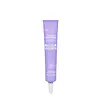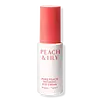What's inside
What's inside
 Key Ingredients
Key Ingredients

 Benefits
Benefits

 Concerns
Concerns

 Ingredients Side-by-side
Ingredients Side-by-side

Water
Skin ConditioningGlycerin
HumectantPalmitoyl Tripeptide-5
Skin ConditioningCetyl Alcohol
EmollientSqualane
EmollientHelianthus Annuus Seed Oil
EmollientTocopheryl Acetate
AntioxidantStearyl Alcohol
EmollientGlycolipids
Skin ConditioningGlyceryl Stearate Citrate
EmollientGlyceryl Laurate
EmollientCeramide NP
Skin ConditioningCeramide AP
Skin ConditioningCeramide EOP
Skin ConditioningPhytosphingosine
Skin ConditioningCholesterol
EmollientSodium Lauroyl Lactylate
EmulsifyingCalendula Officinalis Flower Extract
MaskingAlthaea Officinalis Root Extract
Skin ConditioningCaffeine
Skin ConditioningAloe Barbadensis Leaf Juice
Skin ConditioningTocopherol
AntioxidantSorbitan Sesquioleate
EmulsifyingAllantoin
Skin ConditioningPanthenol
Skin ConditioningXanthan Gum
EmulsifyingGlyceryl Stearate
EmollientPhenoxyethanol
PreservativeEthylhexylglycerin
Skin ConditioningWater, Glycerin, Palmitoyl Tripeptide-5, Cetyl Alcohol, Squalane, Helianthus Annuus Seed Oil, Tocopheryl Acetate, Stearyl Alcohol, Glycolipids, Glyceryl Stearate Citrate, Glyceryl Laurate, Ceramide NP, Ceramide AP, Ceramide EOP, Phytosphingosine, Cholesterol, Sodium Lauroyl Lactylate, Calendula Officinalis Flower Extract, Althaea Officinalis Root Extract, Caffeine, Aloe Barbadensis Leaf Juice, Tocopherol, Sorbitan Sesquioleate, Allantoin, Panthenol, Xanthan Gum, Glyceryl Stearate, Phenoxyethanol, Ethylhexylglycerin
Water
Skin ConditioningCetyl Ethylhexanoate
EmollientPropanediol
SolventButylene Glycol
Humectant1,2-Hexanediol
Skin ConditioningGlycerin
HumectantNiacinamide
SmoothingCetearyl Alcohol
EmollientSodium Hyaluronate
HumectantSodium Acetylated Hyaluronate
HumectantHydrolyzed Hyaluronic Acid
HumectantBambusa Textilis Stem Extract
Skin ConditioningArctium Lappa Root Extract
Skin ConditioningMorus Alba Leaf Extract
Skin ConditioningPrunus Persica Fruit Extract
AbrasiveBakuchiol
AntimicrobialRosa Rubiginosa Seed Oil
EmollientDaucus Carota Sativa Root Water
MaskingBrassica Oleracea Italica Extract
AstringentPanax Ginseng Root Extract
EmollientSpinacia Oleracea Leaf Extract
Skin ConditioningAloe Barbadensis Leaf Extract
EmollientAcetyl Octapeptide-3
HumectantCamellia Sinensis Leaf Extract
AntimicrobialCucumis Sativus Extract
Skin ConditioningApium Graveolens Extract
Skin ConditioningMelia Azadirachta Leaf Extract
Skin ConditioningCaprylyl Glycol
EmollientSorbitan Olivate
EmulsifyingLactuca Scariola Sativa Leaf Extract
Skin ConditioningCeramide NP
Skin ConditioningCoccinia Indica Fruit Extract
Skin ConditioningMelia Azadirachta Flower Extract
Skin ConditioningTocopheryl Acetate
AntioxidantFerulic Acid
AntimicrobialTocopherol
AntioxidantPanthenol
Skin ConditioningCaprylic/Capric Triglyceride
MaskingMangifera Indica Seed Butter
Skin ConditioningAdenosine
Skin ConditioningCetearyl Olivate
Hydrogenated Rapeseed Alcohol
EmollientBetaine
HumectantAcrylates/C10-30 Alkyl Acrylate Crosspolymer
Emulsion StabilisingTromethamine
BufferingEthylhexylglycerin
Skin ConditioningPolyglyceryl-4 Oleate
EmulsifyingGlyceryl Olivate
EmollientGlyceryl Stearate
EmollientPropylene Glycol
HumectantAsparagus Officinalis Extract
Skin ConditioningHydrogenated Lecithin
EmulsifyingPhosphoric Acid
BufferingCorallina Officinalis Extract
Skin ConditioningWater, Cetyl Ethylhexanoate, Propanediol, Butylene Glycol, 1,2-Hexanediol, Glycerin, Niacinamide, Cetearyl Alcohol, Sodium Hyaluronate, Sodium Acetylated Hyaluronate, Hydrolyzed Hyaluronic Acid, Bambusa Textilis Stem Extract, Arctium Lappa Root Extract, Morus Alba Leaf Extract, Prunus Persica Fruit Extract, Bakuchiol, Rosa Rubiginosa Seed Oil, Daucus Carota Sativa Root Water, Brassica Oleracea Italica Extract, Panax Ginseng Root Extract, Spinacia Oleracea Leaf Extract, Aloe Barbadensis Leaf Extract, Acetyl Octapeptide-3, Camellia Sinensis Leaf Extract, Cucumis Sativus Extract, Apium Graveolens Extract, Melia Azadirachta Leaf Extract, Caprylyl Glycol, Sorbitan Olivate, Lactuca Scariola Sativa Leaf Extract, Ceramide NP, Coccinia Indica Fruit Extract, Melia Azadirachta Flower Extract, Tocopheryl Acetate, Ferulic Acid, Tocopherol, Panthenol, Caprylic/Capric Triglyceride, Mangifera Indica Seed Butter, Adenosine, Cetearyl Olivate, Hydrogenated Rapeseed Alcohol, Betaine, Acrylates/C10-30 Alkyl Acrylate Crosspolymer, Tromethamine, Ethylhexylglycerin, Polyglyceryl-4 Oleate, Glyceryl Olivate, Glyceryl Stearate, Propylene Glycol, Asparagus Officinalis Extract, Hydrogenated Lecithin, Phosphoric Acid, Corallina Officinalis Extract
Ingredients Explained
These ingredients are found in both products.
Ingredients higher up in an ingredient list are typically present in a larger amount.
Ceramide NP is a type of ceramide and formally known as ceramide 3.
Ceramides are intercellular lipids naturally found in our skin that bonds dead skin cells together to create a barrier. They are known for their ability to hold water and thus are a great ingredient for dry skin.
Ceramides are an important building block for our skin barrier. A stronger barrier helps the skin look more firm and hydrated. By bolstering the skin ceramides act as a barrier against irritating ingredients. This can help with inflammation as well.
If you would like to eat ceramides, sweet potatoes contain a small amount.
Read more about other common types of ceramides here:
Ceramide AP
Ceramide EOP
Ethylhexylglycerin (we can't pronounce this either) is commonly used as a preservative and skin softener. It is derived from glyceryl.
You might see Ethylhexylglycerin often paired with other preservatives such as phenoxyethanol. Ethylhexylglycerin has been found to increase the effectiveness of these other preservatives.
Glycerin is already naturally found in your skin. It helps moisturize and protect your skin.
A study from 2016 found glycerin to be more effective as a humectant than AHAs and hyaluronic acid.
As a humectant, it helps the skin stay hydrated by pulling moisture to your skin. The low molecular weight of glycerin allows it to pull moisture into the deeper layers of your skin.
Hydrated skin improves your skin barrier; Your skin barrier helps protect against irritants and bacteria.
Glycerin has also been found to have antimicrobial and antiviral properties. Due to these properties, glycerin is often used in wound and burn treatments.
In cosmetics, glycerin is usually derived from plants such as soybean or palm. However, it can also be sourced from animals, such as tallow or animal fat.
This ingredient is organic, colorless, odorless, and non-toxic.
Glycerin is the name for this ingredient in American English. British English uses Glycerol/Glycerine.
Learn more about GlycerinGlyceryl Stearate is a mix of glycerin and stearic acid.
It is used to stabilize the mixing of water and oil ingredients. By preventing these ingredients from separating, it can help elongate shelf life. It can also help thicken the product's texture.
As an emollient, it helps soften skin and supports barrier-replenishing ingredients.
In cosmetics, Glyceryl Stearate is often made from vegetable oils or synthetically produced.
This ingredient may not be fungal-acne safe
Fun fact: The human body also creates Glyceryl Stearate naturally.
Learn more about Glyceryl StearatePanthenol is a common ingredient that helps hydrate and soothe the skin. It is found naturally in our skin and hair.
There are two forms of panthenol: D and L.
D-panthenol is also known as dexpanthenol. Most cosmetics use dexpanthenol or a mixture of D and L-panthenol.
Panthenol is famous due to its ability to go deeper into the skin's layers. Using this ingredient has numerous pros (and no cons):
Like hyaluronic acid, panthenol is a humectant. Humectants are able to bind and hold large amounts of water to keep skin hydrated.
This ingredient works well for wound healing. It works by increasing tissue in the wound and helps close open wounds.
Once oxidized, panthenol converts to pantothenic acid. Panthothenic acid is found in all living cells.
This ingredient is also referred to as pro-vitamin B5.
Learn more about PanthenolTocopherol (also known as Vitamin E) is a common antioxidant used to help protect the skin from free-radicals and strengthen the skin barrier. It's also fat soluble - this means our skin is great at absorbing it.
Vitamin E also helps keep your natural skin lipids healthy. Your lipid skin barrier naturally consists of lipids, ceramides, and fatty acids. Vitamin E offers extra protection for your skin’s lipid barrier, keeping your skin healthy and nourished.
Another benefit is a bit of UV protection. Vitamin E helps reduce the damage caused by UVB rays. (It should not replace your sunscreen). Combining it with Vitamin C can decrease sunburned cells and hyperpigmentation after UV exposure.
You might have noticed Vitamin E + C often paired together. This is because it is great at stabilizing Vitamin C. Using the two together helps increase the effectiveness of both ingredients.
There are often claims that Vitamin E can reduce/prevent scarring, but these claims haven't been confirmed by scientific research.
Learn more about TocopherolTocopheryl Acetate is AKA Vitamin E. It is an antioxidant and protects your skin from free radicals. Free radicals damage the skin by breaking down collagen.
One study found using Tocopheryl Acetate with Vitamin C decreased the number of sunburned cells.
Tocopheryl Acetate is commonly found in both skincare and dietary supplements.
Learn more about Tocopheryl AcetateWater. It's the most common cosmetic ingredient of all. You'll usually see it at the top of ingredient lists, meaning that it makes up the largest part of the product.
So why is it so popular? Water most often acts as a solvent - this means that it helps dissolve other ingredients into the formulation.
You'll also recognize water as that liquid we all need to stay alive. If you see this, drink a glass of water. Stay hydrated!
Learn more about Water